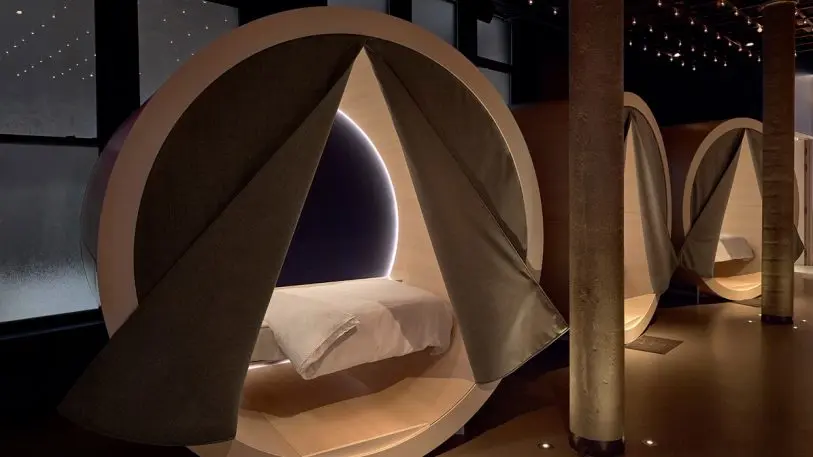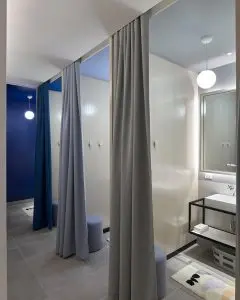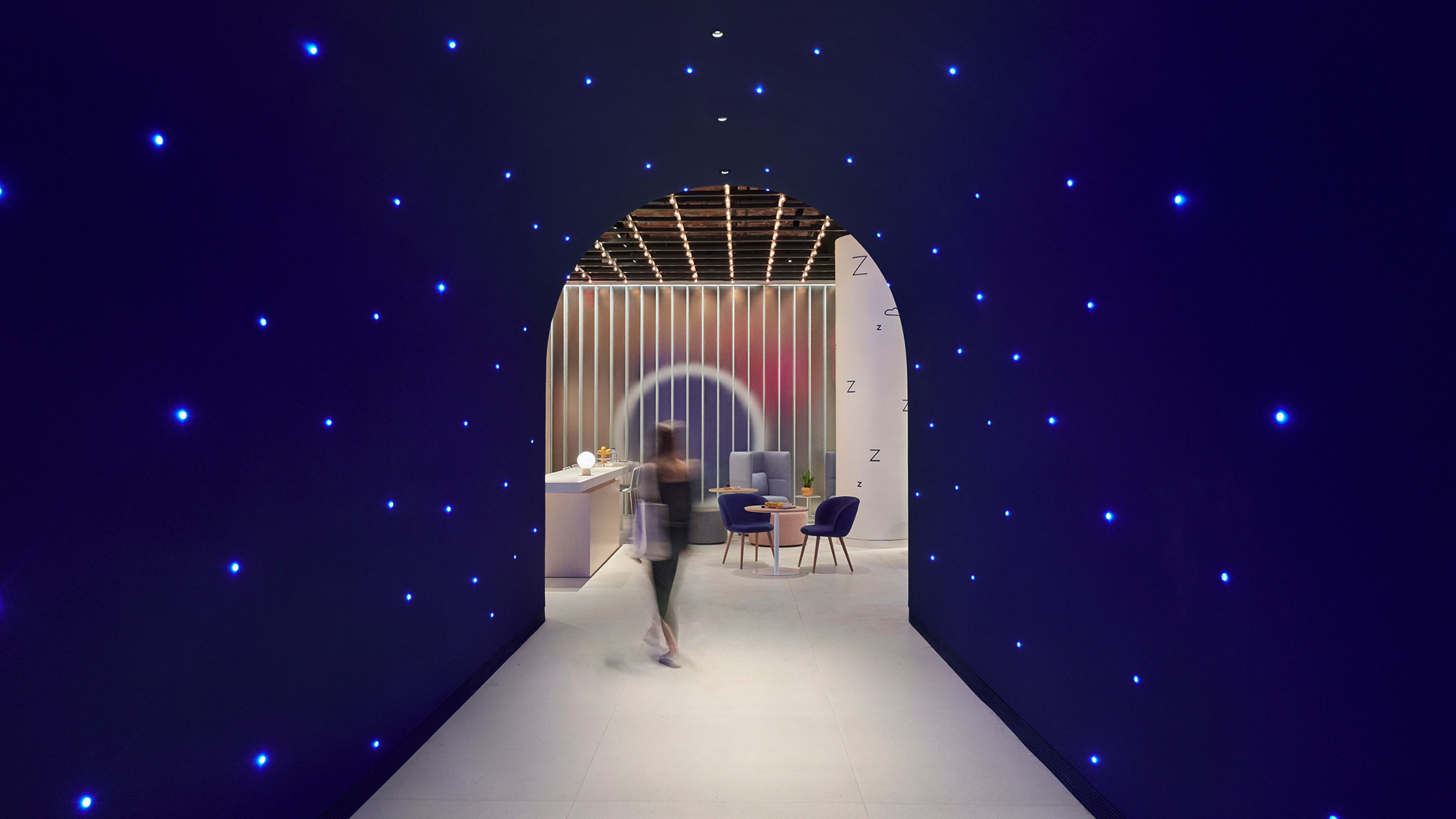In some ways, it was like getting ready for bed. I changed into pajamas, donned some socks, and tried to prepare my mind for sleep. Then, an attendant led me to a large circular nap pod, where a twin-sized bed with crisp white linens awaited. She closed the large fabric flaps and I was left alone in my little cocoon.
“Sweet dreams, Katharine,” said a hand-written note on my pillow. I turned off the light and closed my eyes.

I was ensconced in a nook at the Dreamery, a new napper’s paradise in the Soho neighborhood of Manhattan. Created by the popular mattress startup Casper, the Dreamery gives anyone access to a nice clean bed outfitted with a Casper mattress, sheets, and pillow, and a surprising number of goodies (pajamas, sleep mask, ear plugs, Casper-branded socks, face wash, toothbrush, and comb that reads “bedhead taming device”) for 45 minutes–all for $25. That might sound expensive for something you can do for free on your couch, but Casper hopes to provide a place to crash for Manhattan busy-bodies who need a catnap during the day, after a red-eye flight, or even before a night out on the town.
It’s also part of an emerging brick-and-mortar retail strategy that many e-commerce startups like Warby Parker, Glossier, and Everlane are adopting. “Nowadays every startup is making stores. For a while it was like, we’re e-commerce only,” says Neil Parikh, cofounder and COO of Casper. “And now everyone’s like, actually, people like stores. But I think that makes sense. I don’t think retail is dead, I just think bad retailers are gonna be.”

But the Dreamery has a different goal from Casper’s stores. “We’re very much trying to destigmatize sleep and napping,” says Eleanor Morgan, SVP of experience at Casper. “The way of doing that is to create a delightful experience where people look forward to coming and sleeping. If everyone felt that way when they were going to bed every night, we’d all probably be getting more sleep.”
Casper’s team first conceived of the Dreamery in response to customer surveys that suggested people wanted more places to sleep outside the home. When the Casper store opened in Soho in February, Morgan says, plenty of customers fell asleep in its miniature houses–confirming the idea that people really did want a place to nap. Parikh wanted to create a nap bar that was more thoughtful and beautifully designed than other similar services. “You either have these . . . nap pods that don’t look like they’ve been cleaned in 10 years, like at airports, or you have nothing,” he says. “We wanted to experiment with: What if you could create a place where you could totally rest and recharge and relax in the middle of the day?”
With this mandate in mind, the first prototypes were built at Casper’s headquarters, and members of the company’s testing community would come through the office, try them out, and give feedback. Casper brought in the architecture firm Hollwich Kushner to bring the final pods to life in Soho.
[Image: courtesy Casper]
The final space itself is like a mix between a trendy coworking space, a spa, and an Instagram-friendly art installation. Upon entering, visitors pass through a large blue tunnel covered in blue twinkling lights that look like stars–Morgan says it’s “designed to help people transition from the outside city environment into something more calm and serene.” You arrive in a lounge-like space that feels somewhat like a cool office, complete with trendy midcentury modern furniture. A long bar lines one end, with a place to check in as well as snacks and complimentary drinks like La Croix and cold brew. There’s a shelf of boring books on topics like corporate accounting, wooden fences, choral speaking, and the history of golf (which may offend some nappers, Morgan acknowledges with a laugh).
For Morgan, the Dreamery’s lounge area represents a new kind of semi-public space. “There are a lot of third places that help you wind up like coffee shops,” she says. “There’s places that help you work, like coworking spaces. But there’s not a lot of places where you can actually wind down.” Such third places, meant specifically to help you recharge, also mirror the shift toward productivity-driven perks in the workplace, where companies are pushing mindfulness by providing meditation rooms, and, yes, even nap pods. Morgan even proposed that companies issue employees quarterly credits to come nap at the Dreamery.

The nap pods themselves are dotted around a large, cavernous room. They look like large wooden rings, a design that’s meant to make the sleeper feel like they’re floating. Heavy fabric curtains are pinned to each side of the curved walls, revealing that the pod is empty; once you climb in, an attendant closes them behind you. Suddenly, you feel like you do have a totally private space–a luxury in New York. “The circular form makes it feel like it’s a lot bigger than it actually is,” Morgan says. “Each one should feel like your own cabana.”
But the curtains and the felt backing of the pod don’t drown out much noise–instead, there’s white noise and subtle sleepy sounds playing in the background for everyone. As I tried to sleep, I could hear people walking quietly outside. Once I sneezed, and was instantly petrified that everyone else could hear me.
The Dreamery isn’t a novel idea. In fact, nap pod companies with similar ambitions have failed in the past. But making money from the napping service isn’t Casper’s goal here: Morgan says that the $25 price tag is just to cover the cost of operation. Instead, the Dreamery is fundamentally a way to grow brand awareness–what Parikh calls “building community.” It goes something like this: A passersby might drop in and decide to take a nap, even just for the novelty of it–and as a result, they try Casper’s products. If they have a good time and enjoy the space, maybe they’ll think of the company the next time they need a mattress.
Since the Dreamery opened last week, Morgan reports that customers have had nothing but positive feedback–and many companies have reached out looking to partner and put the Dreamery in new contexts: coworking spaces, airports, or even real estate developments. That all seems in line with Casper’s growing physical retail strategy. “I think you’ll see a lot more stuff in the physical world from us,” Parikh says. “We’re doing stuff with Target, our own stores, the Dreamery, nap mobiles which travel around the country.”
Related: The War To Sell You A Mattress Is An Internet Nightmare
By the time my 45 minutes were over, I’d managed to doze, though not quite fall asleep. Despite the effort that went into making the nap nooks as quiet as possible, the background soundtrack and the shuffle of fellow nappers just outside were a tad too annoying. Even in the midst of a summer Friday afternoon, I couldn’t still my thoughts. And every so often, I’d feel a vibrating rumble that could only be the New York City subway, running its course below the ground. Despite Casper’s best efforts, I was still in the city that never sleeps.
Recognize your brand’s excellence by applying to this year’s Brands That Matter Awards before the early-rate deadline, May 3.





